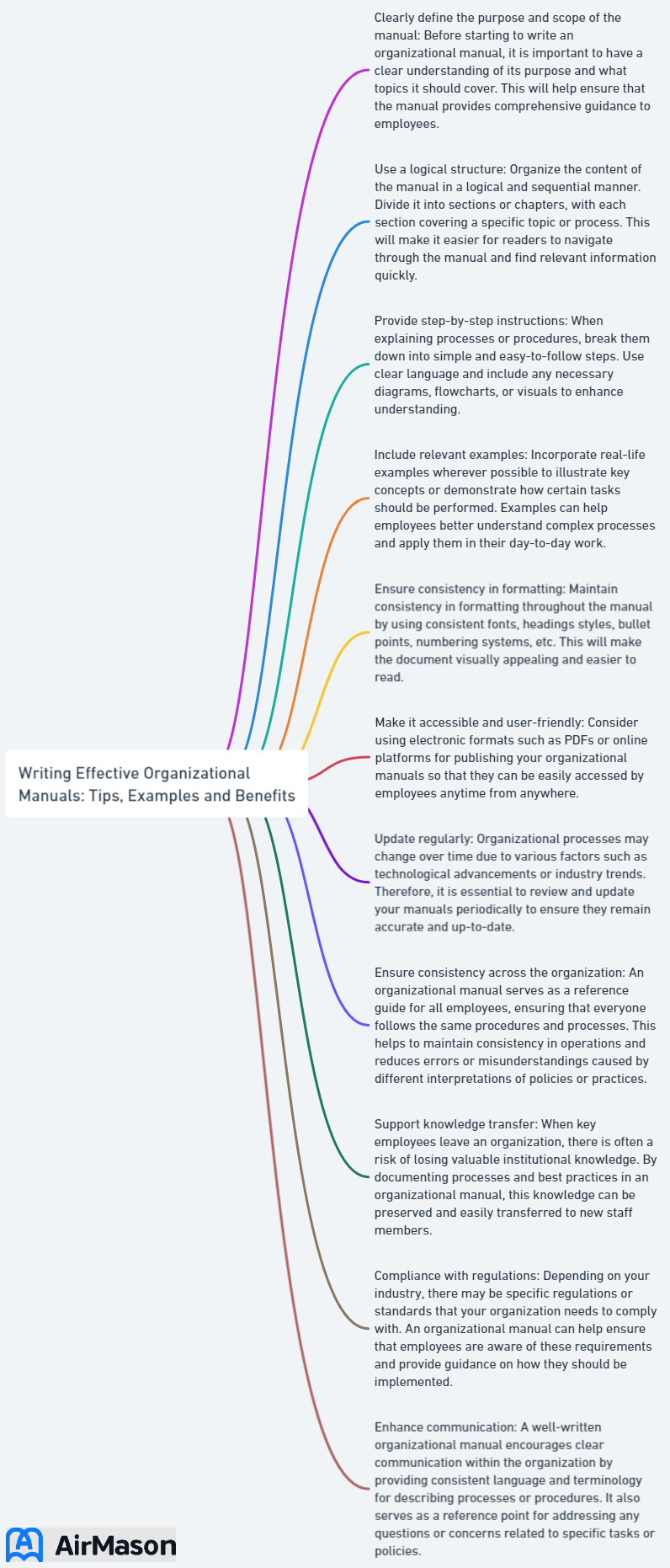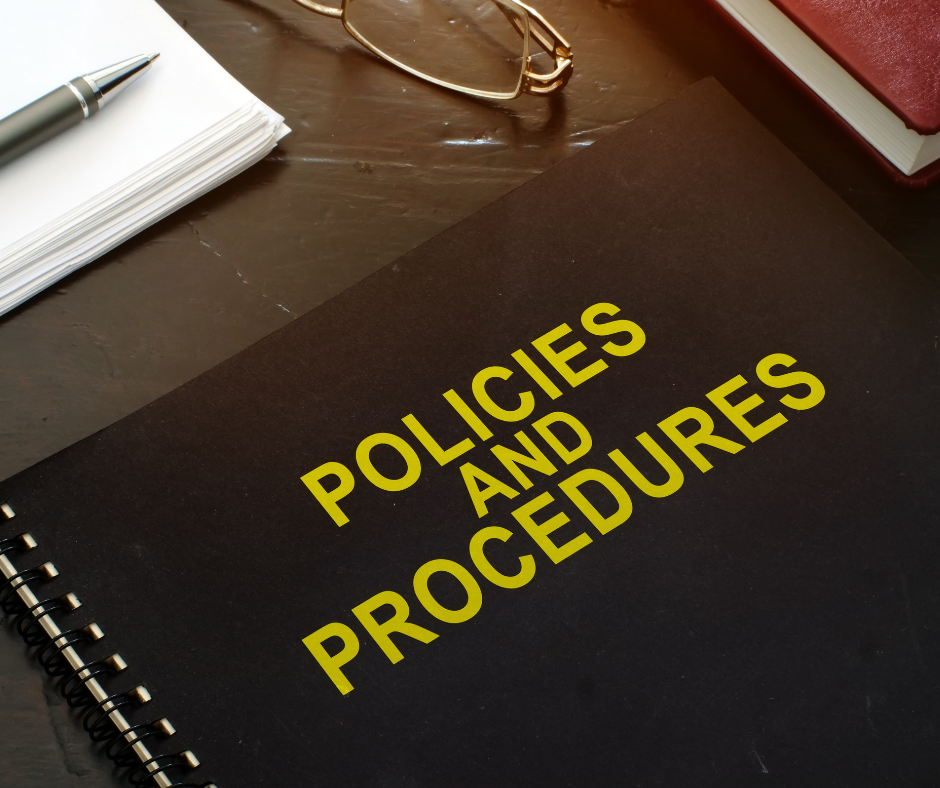
Have you ever wondered how businesses maintain consistency, efficiency, and harmony in their operations? The secret lies in well-structured organizational manuals! In this blog post, we’ll delve into the world of organizational manuals, exploring their purpose, key components, tips for writing an effective one, legal considerations, and benefits. Let’s unlock the power of organizational manuals for your business!
Key Takeaways
- Organizational manuals are comprehensive documents outlining company policies, procedures and job responsibilities.
- Writing an effective organizational manual requires gathering information, organizing content and ensuring clarity & consistency with legal considerations.
- Benefits of implementing an organizational manual include streamlined operations, improved employee onboarding/training & risk reduction.
Understanding Organizational Manuals
Organizational manuals are the backbone of any successful business, encapsulating the principles, practices, and guidelines that govern an organization effectively. From training programs to policies and procedures, these manuals serve as a comprehensive reference point for employees and managers alike.
Having a grasp on their purpose and the variety of types at your disposal paves the way for you to develop an organizational manual that aligns with your company’s unique needs and prerequisites.

Definition and Purpose
An organization manual, also known as an organizational manual, is a comprehensive guide that provides managers and employees with vital information regarding company policies, procedures, and job responsibilities. Its primary objective is to act as a reference point, delineating company policies, procedures, and job responsibilities, while also showcasing the company’s commitment to its mission and values.
Regular examination and modifications are needed to keep organizational manuals current and relevant. This is particularly important when major policies are altered, personnel records are updated, or there is a requirement for such action. Keeping your organizational manual updated guarantees its continued value as a resource for your employees.
Types of Organizational Manuals
Organizational manuals, such as a policy manual, can be customized to suit the unique requirements of a particular organization. This ensures that the manual complies with relevant laws, regulations, and industry standards. Policy manuals furnish instructions for the enforcement of policies and the procedure to be followed for executing them.
Creating an organizational manual can be costly and time-consuming, especially when it involves gathering information, drafting policies and procedures, and ensuring that employees are well-informed about the manual’s contents. Nonetheless, the benefits of having a well-crafted organizational manual far outweigh the challenges, making it an essential investment for any organization.
HR Manual Template
An HR manual template is an essential tool for establishing and maintaining a structured and standardized approach to human resources management within an organization. This template serves as a comprehensive guide outlining the company’s policies, procedures, and guidelines related to various HR functions. It typically covers areas such as employee onboarding, performance management, employee relations, benefits administration, and code of conduct. By utilizing an HR manual template, businesses can streamline communication of important HR information to employees, ensuring they have a clear understanding of the organization’s expectations and policies. Customizing this template to align with the specific needs and culture of the company can help promote consistency and compliance across the workforce, fostering a positive and harmonious work environment.
Key Components of an Organizational Manual

An organizational manual is composed of several essential elements, including company information, policies and procedures, and job descriptions. Having a comprehensive and up-to-date manual ensures that all legal policies and regulations are accurately represented, providing a strong foundation for the smooth functioning of your business.
We will now delve into these key components.
Company Information
The company information section of an organizational manual serves as a vital source of background information about your organization. It includes details about:
- The company’s mission
- Values
- Goals
- Company history
- Hierarchy
Furthermore, it should comply with any applicable state laws and regulations.
In addition to providing an overview of your organization, the company information section also sets the tone for the rest of the manual. Articulating your company’s mission, values, and objectives allows you to affirm your company’s commitment to your employees and establish a strong foundation for your organization’s culture.
Policies and Procedures

The policies and procedures section forms the core of your organizational manual. It provides detailed guidelines for company operations, covering topics such as:
- Conduct
- Compensation
- Benefits
- Human resources
These guidelines establish the standard of behavior within the organization and ultimately define the success of daily operations, taking into account specific rules.
To craft effective policies and procedures, follow these steps:
- Compile a list of topics to document.
- Gather credible source material.
- Build a coherent and organized policy framework.
- Compose an initial draft of each policy and procedure.
- Review and refine the drafts.
- Circulate the drafts for feedback.
- Obtain final approval for the policies and procedures.
By following these detailed procedures, you can ensure that your policies and procedures are well-crafted and effective.
Job Descriptions and Responsibilities
Job descriptions and responsibilities play a vital role in an organizational manual by outlining the primary function and roles of each position within the organization, including management positions. A well-crafted job description in an organizational manual should include:
- The job title
- Job duties and responsibilities
- Explanatory phrases that provide context for the tasks and duties
- Outcome-focused language
Providing clear and detailed job descriptions in your organizational manual guarantees that employees understand their roles and their contribution to the company’s overall objectives. This, in turn, helps to foster a sense of ownership and responsibility among employees, ultimately boosting productivity and job satisfaction.
Templates for Training Manuals
Templates for training manuals are invaluable tools for creating structured and effective training materials. These templates serve as a foundation upon which to build comprehensive manuals, ensuring that important information is organized and presented in a clear and consistent manner. They typically include predefined sections for topics such as objectives, content, exercises, and assessments, making it easy to tailor the manual to your specific training needs. Whether you’re developing materials for employee onboarding, software tutorials, safety procedures, or any other training program, these templates can significantly streamline the process. Moreover, they often come with customizable design elements, allowing you to maintain a professional and cohesive look throughout your training materials.
Writing an Effective Organizational Manual

Now that we’ve explored the key components of an organizational manual, it’s time to delve into the tips and best practices for creating a well-organized, clear, and consistent manual.
Adherence to these general guidelines enables you to develop a manual that conveys crucial information to your employees and promotes smooth operations within your organization.
Gathering Information
Collecting the necessary data and information for your organizational manual is a crucial step in its creation. This may involve:
- Conducting a comprehensive business analysis
- Obtaining existing company documents
- Distinguishing between primary and secondary sources
- Arranging the information in a systematic manner
One effective strategy for gathering information is to conduct interviews with key stakeholders and subject matter experts within your organization. Asking relevant questions and documenting the responses allows you to acquire valuable insights for inclusion in your manual.
Organizing Content
Once you’ve gathered the necessary information, the next step is to organize the content in a logical and easy-to-follow manner. This can be achieved by dividing the manual into sections and subsections, utilizing headings and subheadings, and incorporating visuals and examples to improve comprehension.
An effective organizational manual should have a precise information structure, with consistent language and formatting throughout. This not only makes the manual more readable but also ensures that employees can easily locate the information they need, ultimately improving the overall efficiency of your organization.
Ensuring Clarity and Consistency
Writing an organizational manual in a clear and concise manner is vital for effective communication. By maintaining consistency in language and formatting throughout the manual, you’ll ensure that your employees can easily understand and follow the guidelines and procedures detailed within. To achieve this, it’s important to write organizational content that is both informative and engaging.
Identifying the intended audience and purpose of your manual is a key step to assure clarity and consistency. Additionally, utilizing headings, subheadings, and detailed subsections can help to break up large chunks of text, making the manual more accessible and reader-friendly.
Lastly, don’t forget to review and revise your manual regularly, ensuring that it remains up-to-date and accurate.
Legal Considerations

Creating an organizational manual isn’t just about providing guidelines and procedures for your employees; it’s also essential to consider the legal aspects of your manual.
In this part, we will examine significant legal considerations for crafting your manual to guarantee compliance with all relevant laws and regulations.
Legal Review Process
Having an attorney review your organizational manual before distributing it to employees is crucial for ensuring compliance with applicable employment laws and regulations. The attorney will verify that your manual is compliant with relevant laws and regulations, providing your organization with a valuable layer of protection against potential legal risks. It is essential that employees notify their supervisors of any discrepancies or concerns they may have after reviewing the manual.
Beyond the legal review process, involving key stakeholders and subject matter experts from your organization in the creation of your manual is fundamental. This will ensure that your manual accurately reflects your company’s policies, procedures, and job responsibilities while adhering to all legal requirements.
Updating for Compliance
Regularly updating your organizational manual is crucial for maintaining compliance with ever-changing laws and regulations in your industry. It’s recommended to review and update your manual at least once every one to three years, or more frequently depending on industry-specific requirements.
Staying updated with changes in laws and regulations provides a safeguard for your organization against potential legal risks and liabilities. An outdated manual could leave your organization exposed to risks and may be insufficient to address relevant legal issues. Therefore, it’s imperative to review and update your manual regularly to ensure legal compliance and reduce legal risks.
Benefits of Implementing an Organizational Manual

With a solid understanding of the components, creation process, and legal considerations of an organizational manual, let’s now explore the benefits of implementing one in your organization.
The advantages of having a well-written organizational manual in place range from streamlined operations to improved employee onboarding.
Streamlined Operations
Organizational manuals play a critical role in promoting efficiency and consistency within your company’s processes and procedures. Outlining standard operating procedures and providing explicit task execution instructions in an organizational manual promotes cohesion and efficiency among your employees.
Moreover, an organizational manual can help eliminate discrepancies and unnecessary steps, reducing wastage and increasing productivity. By standardizing processes, your employees can work more effectively as a team, ultimately resulting in improved efficiency and enhanced outcomes.
Improved Employee Onboarding and Training
A well-crafted organizational manual serves as a valuable resource for new employees, reducing training time and ensuring consistent training across the organization. Providing a comprehensive guide for new hires in your manual speeds up their familiarization with their roles and responsibilities within your company.
In addition to streamlining the onboarding process, an organizational manual can also help to foster a sense of ownership and responsibility among your employees. This, in turn, leads to increased job satisfaction and productivity, ultimately contributing to the overall success of your organization.
Risk Reduction
Organizational manuals play a crucial role in minimizing company risks by providing necessary information and guidelines for maintaining safety and compliance. Outlining the company’s policies, procedures, and expectations in your manual keeps employees informed of their obligations and the consequences of non-compliance.
An organizational manual can help to reduce legal risks by:
- Ensuring that your company complies with all relevant laws and regulations
- Protecting your organization from potential liabilities
- Demonstrating your commitment to maintaining a fair and ethical work environment.
Manual of Operations Template
A manual of operations template serves as a structured framework that outlines the standardized procedures and guidelines for carrying out various tasks within an organization. The “manual of operations template” encapsulates a comprehensive document that delineates the specific steps, protocols, and best practices essential for the seamless functioning of an enterprise. This template typically includes sections detailing operational processes, roles and responsibilities, workflow charts, safety protocols, troubleshooting guides, and other pertinent information vital for smooth operations. Tailoring a “manual of operations template” to suit an organization’s unique needs ensures consistency and coherence in operations, promoting efficiency and streamlining processes. By utilizing a well-designed manual of operations template, organizations can enhance productivity, reduce errors, and facilitate effective training and onboarding for employees.
Examples of Organizational Manuals

Real-life examples of organizational manuals can provide valuable insights into how different companies approach the creation and implementation of these essential documents.
This section highlights examples of organizational manuals from both small businesses and large corporations, demonstrating their unique contents and structures.
Small Business Example
A small business organizational manual typically includes:
- An overview of the company’s mission statement
- Organization chart and structure
- Roles
- Standard operating procedures
This provides employees with a clear understanding of the company’s values, objectives, and expectations, helping to foster a strong organizational culture and streamline operations.
In addition to the general contents, a small business manual may also contain specific information relevant to the company’s industry or unique processes. This tailored approach ensures that the manual remains relevant and useful for employees, ultimately contributing to the overall success of the company.
Large Corporation Example
Organizational manuals for large corporations tend to be more comprehensive and intricate compared to their small business counterparts. Large organizations often have multiple divisions, policies, and procedures that need to be documented, resulting in a more extensive and detailed manual.
In addition to the fundamental components found in small business manuals, large corporations may also include detailed information on their organizational structure, processes, and procedures. This helps to provide employees with a thorough understanding of the company’s operations, ensuring that everyone is on the same page and working towards a common goal.
Summary
In conclusion, a well-crafted organizational manual is essential for any business, serving as a comprehensive guide that outlines the company’s mission, values, goals, and operations. By understanding the components, creation process, and legal considerations involved, you’ll be better equipped to create a manual that effectively communicates crucial information to your employees and ensures smooth operations within your organization. With the tips and insights provided in this blog post, it’s time to embark on the journey of creating your very own organizational manual and unlock the full potential of your business!
Frequently Asked Questions
What are the contents of organization manual?
An Organization Manual contains a structured summary of all the company’s regulations, including organizational structure, management policies, performance management and communication practices. It also includes details about the company history, goals, definitions and guidelines.
How do you write an organizational manual?
To write an organizational manual, create a title and provide an introduction explaining the purpose of the policies and procedures. Then, outline each policy’s conditions and establish the procedure manual’s scope. Finally, delegate responsibilities and validate the procedures.
What are the four types of manual?
Policy, Organization, Rules & Regulations and Departmental Manuals are the four types of Manuals available. These Manuals provide information related to policy decisions, organizational details, rules & regulations and departmental procedures respectively. Each type of Manual serves a different purpose. Policy Manuals provide information on policy decisions made by the organization. Organization Manuals provide details on the structure and functioning of the organization. Rules & Regulations
What is a manual in business?
A manual in business is a document which details how to carry out standard business processes, such as SOPs, hierarchy, contact details, and emergency procedures. It ensures that employees understand how to get things done with maximum efficiency and assists in the implementation of uniformity within departments. The manual is an important tool for any business, as it helps to ensure that all employees are on the same page and that processes are carried out in a consistent manner. It also helps to reduce the amount of time spent on training new employees,
How often should an organizational manual be updated?
Organizational manuals should be updated at least every one to three years, or more frequently depending on industry requirements, to remain legally compliant and reduce risk.